Your Guide to a Captain Cook Snorkel Tour
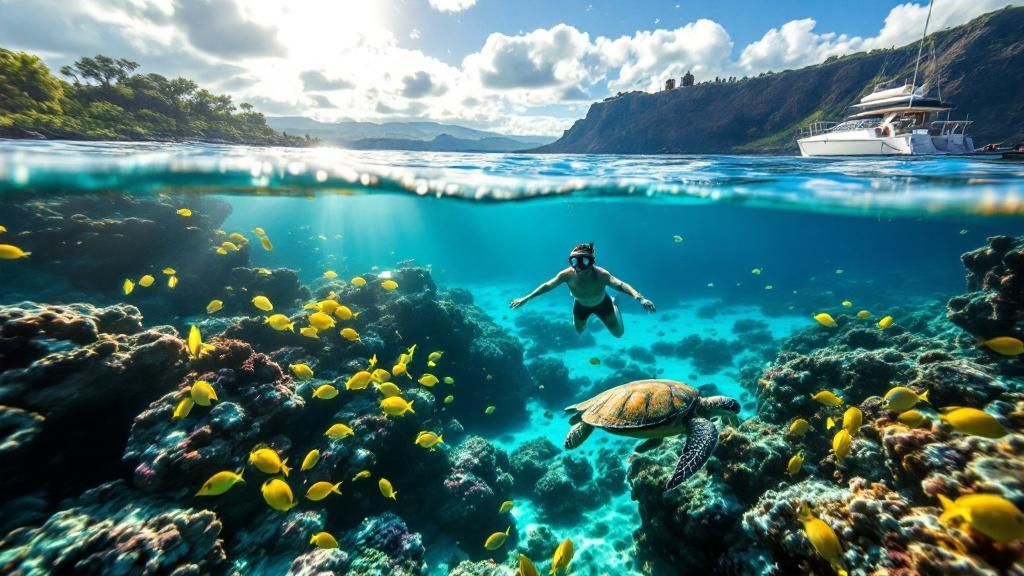
A Captain Cook snorkel tour is a truly unforgettable adventure, blending world-class snorkeling in a protected marine sanctuary with a fascinating peek into Hawaiian history. This isn't just another day on the water; it’s a journey to Kealakekua Bay, a place famous for both its unbelievable underwater life and its pivotal role in Hawaii’s story.
Why Kealakekua Bay Is a World-Class Snorkel Spot
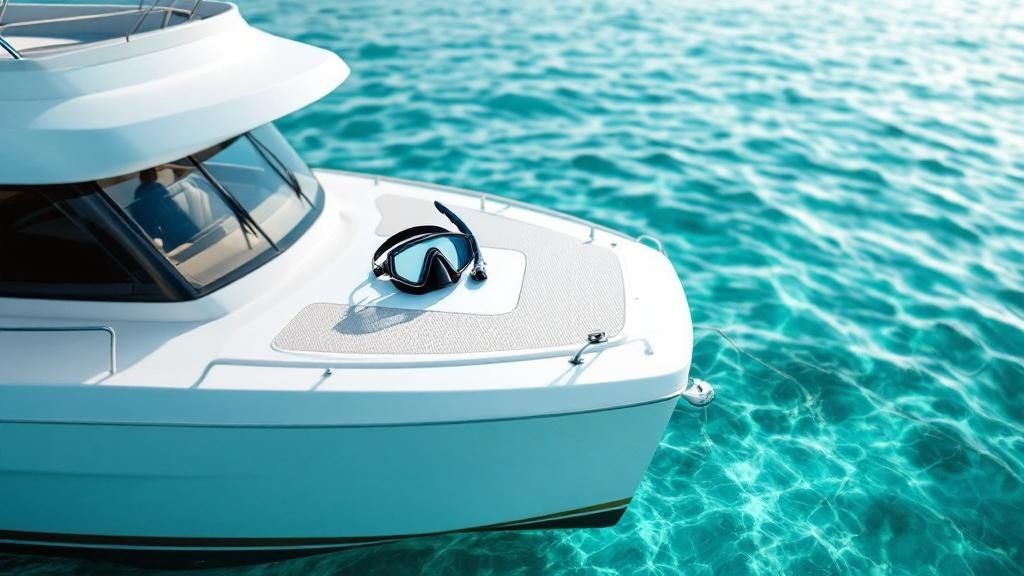
Imagine just floating in calm, turquoise water as schools of brilliant tropical fish glide all around you. That’s the core experience waiting for you on a Captain Cook snorkel tour in Kealakekua Bay, a spot that consistently lands on lists of Hawaii's best snorkeling destinations. This guide is your complete resource for planning the perfect adventure into this protected marine paradise.
The real magic of this tour is its unique mix of nature and history. It’s about more than just seeing colorful fish; it's about connecting with a powerful story. Think of it as visiting a spectacular natural museum where the exhibits are living coral reefs and the gallery walls hold tales of ancient Hawaiian culture and dramatic European exploration. This is what sets it apart from any other snorkel trip on the Big Island.
A Sanctuary Teeming with Life
The star of the show is Kealakekua Bay itself. As a designated Marine Life Conservation District, the area is a safe haven where marine ecosystems can thrive without the pressures of fishing or heavy boat traffic. This protection has allowed the underwater world to flourish, creating a bustling aquatic city that feels pristine and untouched.
Because of this special status, your experience is nothing short of exceptional. The bay's calm, sheltered waters often have visibility exceeding 100 feet, giving you a crystal-clear window into the vibrant life below. This incredible clarity and abundance of marine life make the bay a magnet for snorkelers from all over the world. In fact, Kealakekua Bay attracts over 190,000 visitors annually, cementing its status as a must-see location. You can explore more about the history and draw of this amazing bay on konahonudivers.com.
The Historical Significance
Beyond its natural beauty, the bay holds immense historical weight. It was right here, in 1779, that Captain James Cook made his first significant contact with the Hawaiian people—an event that forever changed the course of the islands' history. This adds a profound layer to your snorkel adventure. You aren’t just swimming in a beautiful spot; you are floating above a site of immense cultural importance.
A great tour doesn't just hand you gear; it gives you context. Your guide will share the stories that bring this stunning landscape to life, covering the key parts of your journey:
- Pristine Snorkeling: Experience the vibrant coral gardens and the diverse fish species they support.
- Rich History: Learn about the bay's role as a sacred site and the story of Captain Cook's arrival and fateful departure.
- Abundant Wildlife: Keep an eye out for spinner dolphins and Hawaiian green sea turtles, known as Honu.
This guide will walk you through every step of planning your Captain Cook snorkel tour, making sure you feel confident and excited for an unforgettable day.
How to Choose Your Perfect Snorkel Tour
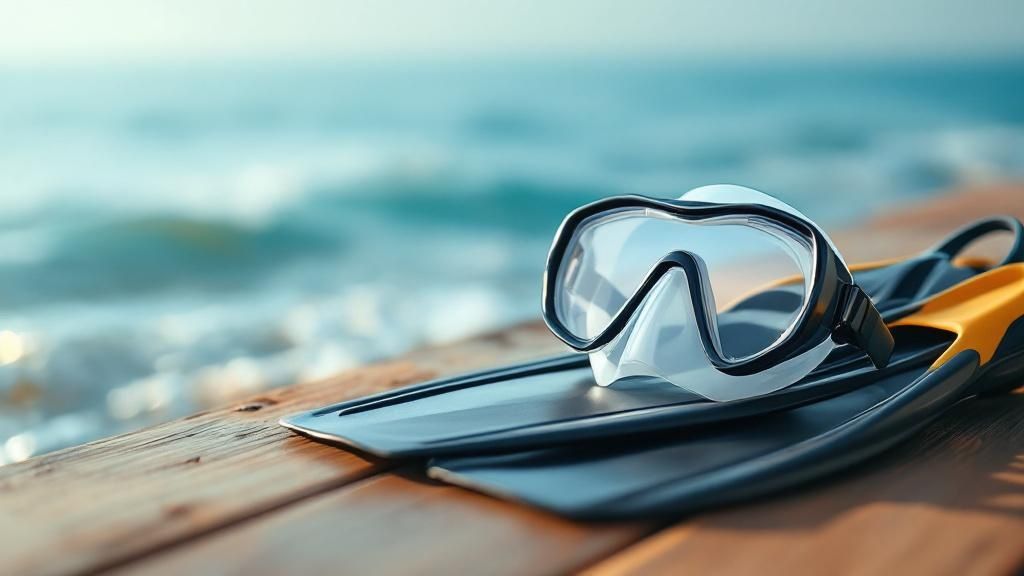
Not all Captain Cook snorkel tours are created equal. Finding the right one can honestly make or break your entire day. Think of it like picking a restaurant: are you in the mood for a quick, exciting bite, or a long, relaxing meal with all the comforts?
Each tour boat has its own vibe, and figuring out what your group wants is the first step toward a trip you'll absolutely love. Your choice shapes everything from the number of people on board to the whole pace of the day.
Comparing Your Main Tour Options
The biggest difference between tours usually comes down to the boat itself. You’ll generally find three types of vessels heading to Kealakekua Bay, and each one is geared toward a different kind of snorkeler. Let’s break them down so you can find your perfect match.
-
Zodiac-Style Rafts: These are the small, fast, and nimble boats built for adventure. They zip you out to the snorkel spot in no time and offer a really intimate, up-close experience with the water. They’re perfect for thrill-seekers and small groups who care more about time in the water than luxuries on the boat.
-
Large Catamarans: Think of these as the stable, spacious cruise ships of the snorkel world. With tons of deck space, shaded areas, onboard restrooms, and often a full lunch, catamarans are a fantastic choice for families with kids, larger groups, or anyone who just wants a smooth ride with plenty of amenities.
-
Private Charters: For the ultimate personalized day, a private charter is the way to go. You get the boat and crew all to yourselves. That means you set the schedule, decide how long to snorkel, and create an adventure that's all your own. It's a premium option, ideal for special occasions or groups who want total privacy.
The structure of a Captain Cook snorkel tour can vary a lot. Small boat tours usually last 3 to 4 hours with 6 to 12 people, costing around $80 to $120. The bigger catamaran trips run 4 to 5 hours with 20 to 40 people and more perks like lunch and restrooms, typically priced between $100 and $150. For a fully custom day, private charters are also an option, often starting at $500 or more.
Matching the Tour to Your Travel Style
So now that you know the basic types, how do you connect them to what you need? What kind of day are you picturing? Answering that question honestly will point you straight to the best tour for your crew.
If you’re a solo traveler or an adventurous couple laser-focused on maximizing your time exploring the reef, a zippy zodiac raft is an awesome choice. These tours feel more like an expedition than a leisurely cruise, keeping the focus squarely on the snorkeling.
On the other hand, if you're traveling with young kids or older family members, the stability and amenities of a large catamaran are priceless. Having shade, bathrooms, and food on hand makes for a much more comfortable and stress-free day for everyone. Many of these bigger boats even have fun extras like waterslides.
Key Takeaway: The "best" tour is totally subjective. It’s not about which boat is technically better, but which one fits your group’s comfort level, budget, and the pace you want for your day.
To help you visualize the differences, here’s a simple table laying out the key features of each tour.
Captain Cook Snorkel Tour Comparison
This table breaks down the main options to help you see, at a glance, which tour type might be the best fit for your group and budget.
| Tour Type | Best For | Typical Duration | Group Size | Price Range |
|---|---|---|---|---|
| Zodiac Raft | Adventurous snorkelers, small groups, maximizing in-water time | 3 – 4 hours | 6 – 16 people | $80 – $120 |
| Catamaran | Families, large groups, those wanting amenities and a relaxed pace | 4 – 5 hours | 20 – 40+ people | $100 – $150 |
| Private Charter | Special occasions, custom itineraries, total privacy | Flexible | Your Group | $500+ |
Choosing the right boat really boils down to what you value most for your day out on the water.
Making the Final Decision
Ultimately, your choice is a balance between adventure and comfort. Do you want a thrilling, fast-paced ride that gets you to the action quickly? Or would you prefer a slower, more luxurious journey with room to stretch out and relax?
There’s really no wrong answer here. Both a nimble zodiac and a spacious catamaran will get you to the same spectacular underwater world in Kealakekua Bay. The key is picking the vessel that makes sure your trip there and back is just as amazing as your time snorkeling with the fish.
By thinking about your group's unique needs, you can confidently book the perfect Captain Cook snorkel tour. To see how these different tour styles come together for an incredible day, you might want to read our complete overview of the Captain Cook snorkel tour experience.
Discovering the Underwater World of Kealakekua Bay
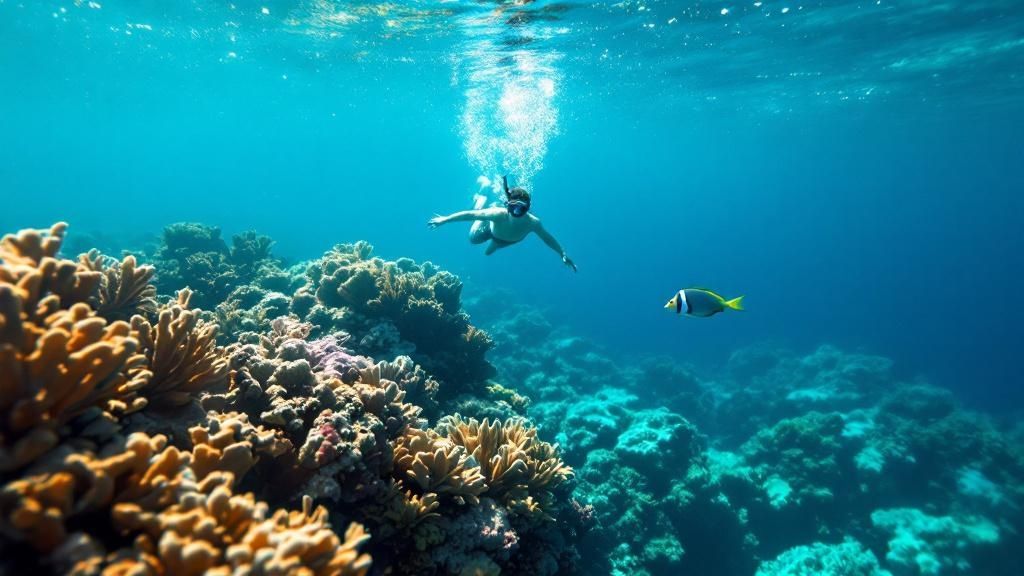
Slipping into the water on a captain cook snorkel tour is like entering another world. The second your mask goes under, the boat sounds fade, replaced by the soft crackling of a busy reef. You're not just looking at fish; you're a guest in a vibrant, living underwater city.
The first thing that hits you is the insane clarity of Kealakekua Bay. It often feels like you’re flying over a submerged landscape, able to see crisp details on the ocean floor dozens of feet down. This isn't just luck; it’s by design.
The Secret to Its Magic: A Marine Life Conservation District
Kealakekua Bay is so spectacular because it's a designated Marine Life Conservation District (MLCD). Think of it as a national park for the ocean. This protected status heavily restricts things like fishing, creating a safe harbor where the underwater world can thrive without pressure.
This protection is the "secret sauce." The coral gardens are healthy and dense, building the foundation for an entire ecosystem. Because it's a safe zone, fish populations explode in number and size, leading to an abundance of life you just don't see in less-protected areas.
For over 30 years, tour operators have been sharing this incredible 315-acre marine sanctuary with visitors. The bay's calm, crystal-clear waters are sheltered from big ocean swells all year, making it incredibly safe and accessible, even for first-timers. You can get more great info on this snorkeling paradise from the folks at Dolphin Discoveries.
Who You Might Meet Beneath the Waves
Every single trip into the bay is different—you never know who’s going to show up. But the cast of characters is always spectacular. Get ready for a sensory overload of color and motion.
Here are a few of the local celebrities you're almost guaranteed to meet:
- Massive Schools of Yellow Tang: Imagine being surrounded by a swirling, golden cloud of thousands of fish. It’s a signature Kealakekua experience.
- Parrotfish (Uhu): You can often hear these guys before you see them. They use their beak-like mouths to crunch on coral, a sound that echoes through the water.
- Shy Moray Eels: Take a close look in the rocky crevices. You might spot a moray eel peeking its head out, watching the world go by from its hideout.
- Hawaii's State Fish: Keep your eyes peeled for the famously named humuhumunukunukuāpuaʻa (reef triggerfish), with its unique and stunning markings.
A Note on Respectful Observation: This explosion of life depends on us. The number one rule is simple: look, don't touch. Admire the coral from a distance, give the animals their space, and only use reef-safe sunscreen. Let's keep this paradise thriving.
The Graceful Honu: Hawaiian Green Sea Turtles
While the swarms of colorful fish are dazzling, the undisputed showstopper for many snorkelers is an encounter with a Honu, the Hawaiian green sea turtle. There's a moment of pure magic when you see one of these ancient mariners gliding effortlessly through the water. It’s something that stays with you.
You might spot them resting on a sandy patch on the bottom or cruising through the coral heads looking for a meal. They’re revered in Hawaiian culture as symbols of good luck and longevity. Just remember to give them plenty of room—a minimum of 10 feet is the rule—so they can go about their business stress-free. Watching them from a respectful distance makes the memory from your captain cook snorkel tour that much more special.
The Story Behind the Captain Cook Monument
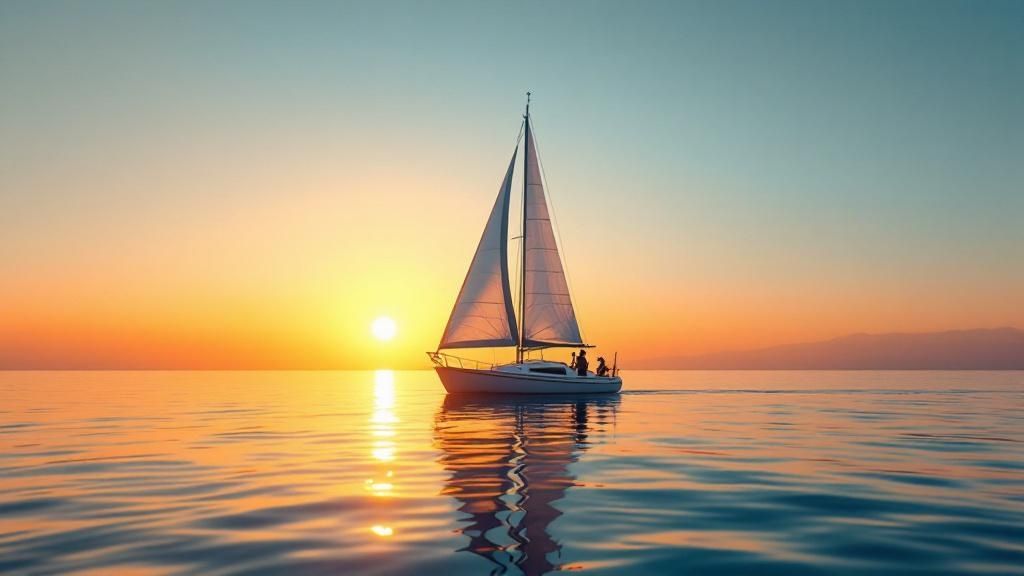
A Captain Cook snorkel tour isn't just a boat trip; it’s a journey back in time. As you glide into the calm, protected waters of Kealakekua Bay, you’re entering one of the most significant historical sites in all of Hawaiʻi. You’re not just floating over a pretty reef—you're in a living museum where Western and Hawaiian cultures first made deep, lasting contact.
It really feels like you've stepped into a history book. The guides on a good tour don't just point out fish; they tell the gripping story of Captain James Cook's arrival in 1779. They bring the past to life, sharing events from both the Western perspective and, more importantly, the deeply meaningful Hawaiian viewpoint. You need both to understand what truly happened here.
A Fateful Arrival
Captain Cook’s timing was, to put it mildly, uncanny. He sailed into the bay right in the middle of the Makahiki festival, a sacred season that lasted for months and was dedicated to Lono, the Hawaiian god of peace, agriculture, and fertility. During Makahiki, all warfare was kapu (forbidden), and the islands were buzzing with celebration and reverence.
Cook’s massive ships, with their towering masts and white sails, looked a lot like the symbols associated with Lono. Because of this, many Native Hawaiians first welcomed him as a divine being. The reception was peaceful and full of honors. Cook and his crew were showered with respect and provisions. But this peaceful first impression wasn't meant to last.
A Tragic Turn of Events
After leaving the bay, Cook's expedition hit a storm that damaged a ship's mast, forcing them to turn back for repairs. By then, the Makahiki season was over. The Hawaiians' perception of the visitors had started to shift. Tensions flared over resources and cultural misunderstandings, leading to a tragic clash.
On February 14, 1779, Cook tried to take a high-ranking Hawaiian chief hostage to get a stolen boat back. The plan backfired, and in the conflict that erupted on the shore, Captain Cook was killed. This complex and somber history is a huge part of what makes Kealakekua Bay so profound.
The real magic of a modern tour is its storytelling. A good guide transforms your swim from just a fun activity into a deep connection with the island's soul, honoring the past by embracing all its complexity.
The guides on a Captain Cook snorkel tour treat this sensitive history with the respect it deserves, making sure the story is told in a way that honors the site's immense cultural significance for Native Hawaiians.
The Monument and Its Unique Status
While you're in the water, you can't miss the stark white obelisk on the shore—the Captain Cook Monument. This 27-foot marker was put up in 1874 to commemorate the spot where the famous explorer died. Here's a fun fact most people don't know: the tiny piece of land it sits on was deeded to the United Kingdom, so it's technically foreign soil.
This is a big reason why most tours view it from the water. The shoreline is rugged and tough to land on, and honestly, the best view is from the bay anyway. From there, you're perfectly positioned over the most vibrant parts of the reef. The monument stands as a silent, powerful reminder of the world-changing events that happened right where you're swimming. To dive deeper into the story, check out our guide to snorkeling at the Captain Cook Monument.
Essential Gear and Safety Tips for Snorkelers
Having a fantastic day on your Captain Cook snorkel tour is all about feeling prepared and comfortable. Once you know what gear to expect and how to stay safe, you can truly relax and just soak in the incredible underwater scenery. Think of this as your quick guide to a totally stress-free adventure.
Most tour operators, including us, provide the main equipment—mask, snorkel, and fins. It’s a bit like a rental car; even if it's not yours, you still need to adjust the mirrors and seat to drive safely. Getting your gear dialed in is the first step to a great time.
Your Standard Snorkel Gear Explained
The gear we provide is your window into Kealakekua Bay's vibrant world. A good fit is everything, so let's walk through the basics.
-
The Mask: A proper seal is the most important thing. To check if a mask fits your face, hold it up without using the strap and gently breathe in through your nose. If it sticks for a few seconds, you’ve got a good seal. A leaky mask is just plain annoying, so don't be shy about asking your guide for a different size.
-
The Snorkel: This is simply your breathing tube. Most modern snorkels have a "splash guard" on top to keep choppy water out and a "purge valve" at the bottom. If you do get a little water inside, just give a firm exhale, and it will push right out through the one-way valve. Easy peasy.
-
The Fins: Fins aren't just for looking cool or going fast; they’re all about moving efficiently so you don't get tired. They should feel snug on your feet, but definitely not painfully tight. Remember to kick from your hips with straight legs—that’ll give you the most power with the least effort.
Expert Tip: Your guides are your best resource on the boat. They are lifeguard-certified and know this equipment inside and out. Always listen to their briefing and follow their instructions. It’s the single best way to ensure a safe and awesome time in the water.
Crucial Safety Practices for Every Snorkeler
Safety is always our top priority, but being aware of a few key practices makes the experience better for everyone. These aren't just rules; they're smart habits that keep you and everyone else safe.
The buddy system is the golden rule for any water activity, even when you're in a guided group. Always keep your snorkel partner and the boat in your sight. It's a simple practice that ensures someone always has your back.
Also, take a moment to get comfortable before you venture too far from the boat. Just float near the ladder for a few minutes, practice breathing through your snorkel, and try clearing it with a sharp puff of air. Building that initial confidence is key to relaxing and really appreciating the marine life around you. For a deeper dive into water preparedness, you can check out our complete guide to essential snorkeling safety tips.
The Golden Rule of Marine Conservation
Beyond your own safety, we all share a responsibility to protect the incredible ecosystem of Kealakekua Bay. The number one rule is simple but vital: look, but never touch.
That beautiful coral reef is a fragile, living animal. A single touch from a hand, or even a bump from a fin, can damage or kill the delicate polyps that have taken centuries to grow. Likewise, chasing or touching marine animals like the Honu (sea turtles) causes them a ton of stress.
Admiring wildlife from a respectful distance is the most rewarding way to experience their world. It also ensures this paradise is preserved for generations to come.
Alright, let's get the logistics sorted out so you can focus on the incredible experience ahead. Planning your Captain Cook Snorkel Tour is pretty simple, but a few key decisions will make sure your day goes off without a hitch. Think of this as the inside scoop to remove any guesswork.
The biggest choice you'll make is what time to go. Hands down, the morning tours are almost always the best bet. The ocean is typically at its calmest then, looking like a sheet of glass, which means fantastic water clarity for snorkeling. It also makes for a much smoother and more comfortable boat ride out to Kealakekua Bay before the afternoon trade winds kick up.
Finding the Right Tour Operator
Once you've decided on a morning trip, the next step is picking a great company. Don't just book the first one you find on Google. You'll want to look for operators with a top-notch safety record, glowing customer reviews, and guides who are lifeguard-certified. A fantastic crew makes all the difference—their knowledge and professionalism can turn a good trip into an absolutely unforgettable one.
Booking ahead is a must, especially if you're visiting during the busy season, like summer or over the winter holidays. The best tours fill up fast, and this is one Big Island experience you really don't want to miss. For all the details and to get your trip locked in, check out the main page for the Captain Cook Snorkel Tour.
Key Planning Tip: Always, and I mean always, check the tour company's cancellation policy. Good operators put safety first and will cancel a trip if the ocean conditions are unsafe, offering you a full refund or a chance to reschedule. That kind of peace of mind is worth its weight in gold.
Your Essential Day-Of Checklist
On the morning of your tour, a little prep goes a long way. Having the right stuff with you means you’ll be comfortable from the moment you leave the harbor until you're cruising back. This is your simple, no-fuss list for a perfect day out on the water.
Here’s what you should definitely bring to make your adventure go smoothly:
- Reef-Safe Sunscreen: This is non-negotiable. Regular sunscreens have chemicals that are seriously harmful to our coral reefs. Go for a mineral-based one with zinc oxide to protect both your skin and the bay's fragile ecosystem.
- Towels and a Dry Change of Clothes: You’ll be so glad you have a dry towel and something comfortable to change into for that relaxing boat ride back to the harbor.
- A Dry Bag: A small dry bag is perfect for stashing your phone, wallet, and keys to keep them safe from splashes while you're on the boat.
- Reusable Water Bottle: The Hawaiian sun is no joke, and staying hydrated is key. Bringing your own bottle is a super easy way to cut down on plastic waste and keep refreshed all day.
Your Top Questions Answered
When you're getting ready for an adventure like the Captain Cook snorkel tour, a few questions always pop up. Getting these sorted out beforehand means you can just relax and enjoy the day. Let's tackle some of the most common ones.
Is This Tour Good for Beginners?
Absolutely. Kealakekua Bay is a snorkeler's dream, especially for newcomers. The bay is naturally protected from the big ocean swells, which keeps the water incredibly calm and clear. It’s the perfect place to get your fins wet for the first time.
Every good tour will kit you out with high-quality flotation gear, like a pool noodle or a snorkel vest. This lets you float on the surface with zero effort, so you can forget about swimming and just focus on the incredible world of fish right below you.
Your guides are your best friends out on the water. They're lifeguard-certified professionals who know exactly how to make sure everyone, no matter their comfort level, has a safe and amazing time.
Can You See Dolphins or Whales?
While Mother Nature never makes guarantees, spotting a pod of playful spinner dolphins is a very common sight. They love the calm waters of the bay for resting and socializing, and we see them often, especially on the morning tours.
And if you're here during whale season (that's typically December through March), you're in for a treat. There's a real chance of seeing humpback whales on the boat ride to and from the snorkel spot. Keep your eyes peeled for that telltale spout or a spectacular breach!
What Is the Best Time of Year to Go?
Honestly, a Captain Cook snorkel tour is fantastic any time of year, thanks to the bay's protected nature. That said, different seasons do have their own perks.
- Summer Months: This is when you'll usually find the absolute calmest, clearest water. The visibility can be mind-blowing.
- Winter Months: You get the incredible bonus of potential humpback whale sightings during their annual migration. It adds a whole other level of excitement to the trip.
Are There Restrooms on the Boats?
This really comes down to the kind of boat your tour uses. The bigger catamarans almost always have a restroom (or a "head," as it's called on a boat), which makes them a solid choice for families or anyone who just likes having more amenities.
The smaller, zippier zodiac-style rafts, on the other hand, usually don't have onboard facilities. It's always a smart move to double-check this detail with the tour operator when you're booking so you know exactly what to expect.
Ready to see the vibrant reefs and soak in the history of Kealakekua Bay for yourself? Kona Snorkel Trips runs expert-guided tours that make this incredible place come alive. Book your unforgettable adventure today!
